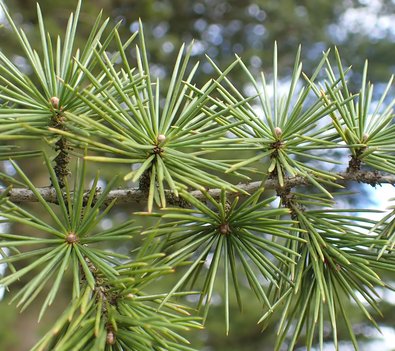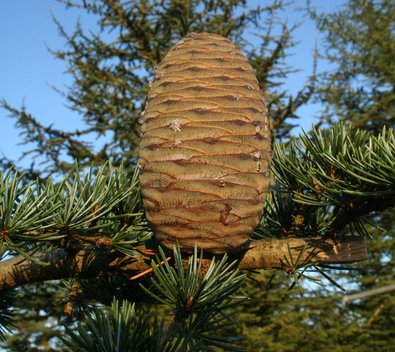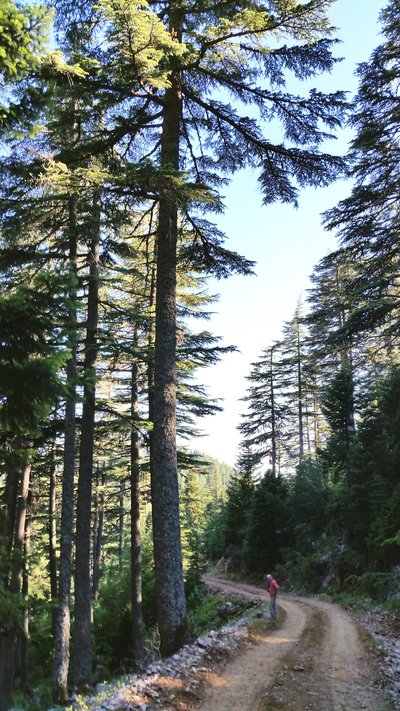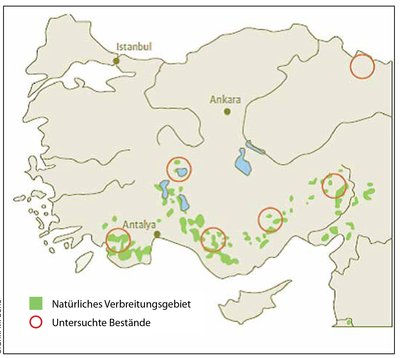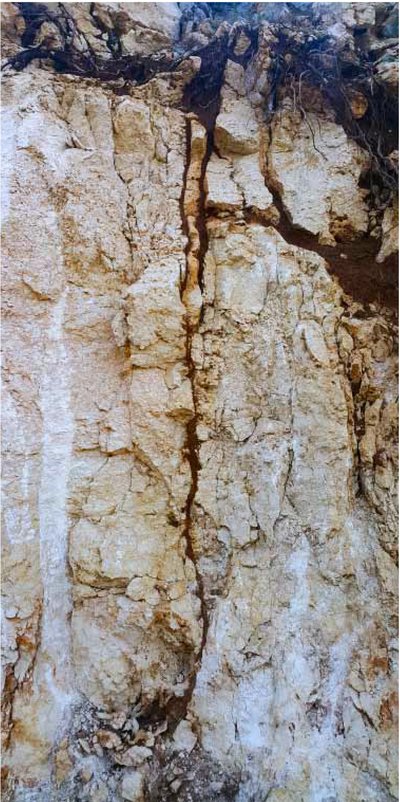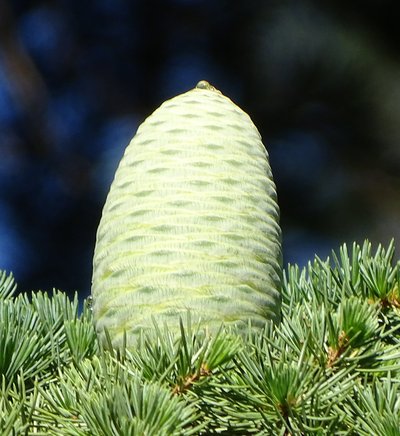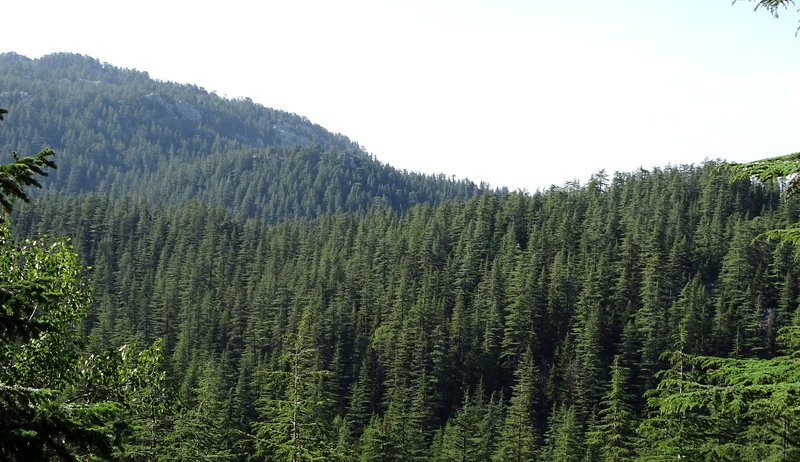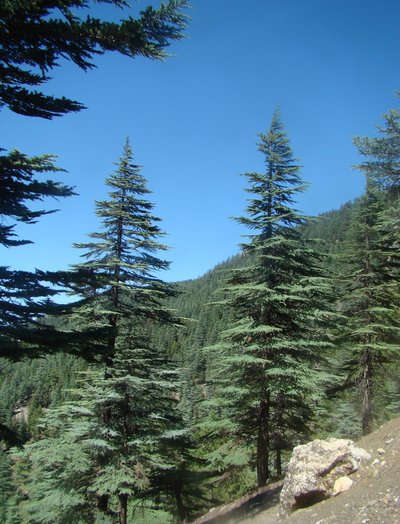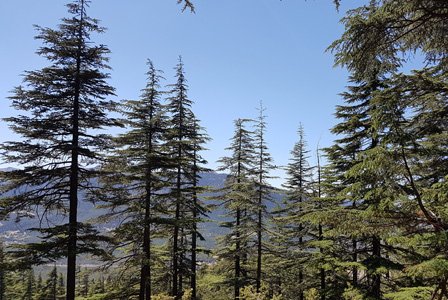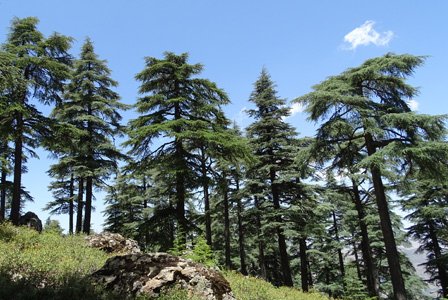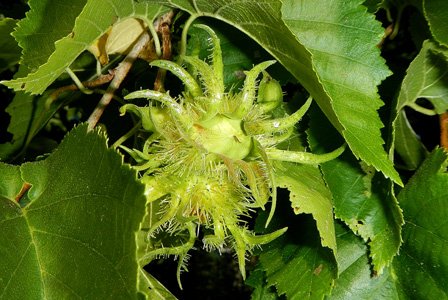In addition to an ability to tolerate dry periods, drought tolerance is becoming increasingly important. So provenances cannot be evaluated for their suitability solely on the basis of analogous climates. Instead, the adaptation of the population to particular microclimatic environmental conditions and the adaptability offered by its genetic diversity should be considered. One tree species that could be considered here is the Lebanese cedar (Cedrus libani). This tree species can easily integrate in forest communities and occurs in mixed forests with both light-loving and shade-tolerant tree species. It has many properties that can promote stand stabilisation in times of climate change. When mixed with native tree species, it can produce valuable wood that is versatile in its uses.
"CorCed" project
The question of where to obtain seed of suitable provenances for Bavarian forests has not been investigated so far. As part of the “CorCed” project funded by the Federal Ministry of Agriculture and Food, several seed crop stands of Lebanon cedar in Turkey were viewed. The aim was to cover different climatic conditions and altitudes in order to be able to assess the potential of this drought-tolerant tree species in provenance trials in Bavaria and Baden-Württemberg. Provenance plays a key role with the Lebanon cedar, as it does with other tree species both native and non-native. As well as growth-relevant traits, the genetic make-up of the individual populations is important, so that its potential to adapt can be assessed.
In spring 2020, four cedar provenance trials were set up in Bavaria and Baden-Württemberg as part of the CorCed project. They include six to seven provenances of Atlas and Lebanon cedar. In addition, more than 20 practical cultivation trials were established throughout Bavaria using selected provenances of these two tree species under different site and environmental conditions, in order to gather initial experience with this species in cooperation with forestry practitioners.
East to west distribution
The natural range of the Lebanon cedar is fragmented and split into two larger areas. One area consists of individual pockets of remnant populations in Lebanon and Syria. The species has been overused in both countries. In Lebanon, only 1,700 ha of the original 500,000 ha still exist; the size of the Syrian populations of Lebanon cedar is not known. The largest population of the Lebanon cedar (Turkish: Toros sediri) is to be found in Turkey. It is divided between forests in the East and West Taurus Mountains. The cedars that occur here are known as Cedrus libani subsp. stenocoma. The area in Turkey (463,500 ha) covers a large part of the western and central Taurus mountains and the Amanus mountain range. As a result of centuries of overuse, the population is fragmented and divided into many island-like individual clusters. Turkey is a world leader in the afforestation of open landscapes and has restocked 400,000 to 500,000 ha of forest over the last 30 years by sowing and planting different tree species. The potential of the forestry sector in Turkey will increase in future as a result.
In its natural range, the Lebanon cedar colonises areas at altitudes between 800 and 2,100 m above sea level. In many places it forms the timberline. Larger and contiguous cedar forests are still to be found in the West Taurus Mountains. Individual clusters grow here at altitudes of 500 to 800 m a.s.l. In times of climate change, our Turkish colleagues are counting on Lebanon cedar in their afforestation programmes, along with black pine. Turkey is currently afforesting more than 10,000 ha annually with Lebanon cedars. In Europe, Lebanese cedar stands are being established in France, Italy and Bulgaria. In Germany and other central European countries, the Lebanon cedar is only known as a park tree; there are few forest areas where it is cultivated.
Site and climate
The Lebanon cedar will grow in calcareous and siliceous soils. In France, its cultivation is particularly recommended on calcareous soils. As it develops a 2 to 3 m long taproot, it can access deeper and therefore fresher layers as well as rocky locations. Because it does not compete well with other tree species, it is often relegated to marginal sites (poor, shallow, rocky and structurally rich ground) in its natural range.
The climatic conditions in the natural range of the Lebanon cedar can vary widely. The Turkish Lebanon cedar thrives in four climate types: “arid”, “semi-arid”, “humid” and “semi-humid”. The average annual precipitation ranges from 600 to 1,300 mm, and at higher altitudes may also exceed 2,000 mm. The natural populations on the south Anatolian coast are in the Mediterranean winter rainfall area. The sub-areas in the Amanus and Aluite Mountains (Syria) and in Lebanon have a lot of rainfall (up to 1,300 mm/year). Higher altitudes have a Mediterranean mountain climate, transitioning in places to a steppe climate. Only about 5 % to 25 % of the annual rainfall usually falls during the growing season from May to September in the area of natural range. The Lebanese cedar copes well with dry periods in the summer months, with precipitation of just 50 to 100 mm. At higher altitudes, the extreme summer drought can be mitigated by the occurrence of fog. From around 1,000 m above sea level, winter precipitation often falls as snow. The snow cover can be up to two metres thick and remain until April. The Lebanon cedar copes well with snow pressure. However, independently of dry periods, it requires at least 500 to 600 mm of precipitation per year for growth. Average annual temperatures range from 6.0 to 15.7 °C. The temperatures in stands in the eastern Taurus mountains can drop to -32 °C in January and rise to 36.8 °C in July. The Lebanon cedar is considered to be less frost-resistant than the Atlas cedar.
Seed collection and propagation
As with native tree species, the choice of provenance of a tree species and the quality and sustainable production of the seed and planting material are important for the selection of the alternative tree species. The Lebanon cedar is subject to the [German] law on forest reproductive material (FoVG). The production, import, export and bringing to market of the reproductive material must be carried out in compliance with the legal requirements as set out in the FoVG. Because of the low economic importance in Germany of this tree species, no areas of provenance have been designated so far in Germany. The production (e.g. plant breeding from foreign seeds) and marketing of forest reproductive material are clearly regulated and the regulations must be complied with. The requirements for the approval and harvesting of such stands are defined by the respective states. Where the seed is produced in third countries that have joined the OECD scheme, its production must be subject to the same conditions as seed production in an EU member state. For the importing of seed from third countries, an import notification must be submitted to the Federal Agency for Agriculture and Food (BLE).
In Turkey, 22 seed crop stands covering an area of 3,437 ha have been selected and approved. In addition, eight seed orchards have been established. For this, plus trees from different regions of Turkey were selected between 1990 and 1995. Since the Lebanon cedar can form its first cones at the relatively young age of 30, these seed orchards will soon be ready for harvesting. Propagation material from non-approved stands of the “source-identified” category is not permitted for use in forests in Germany, and nor is harvesting in individual arboretums, parks, or plantations of exotic species.
Visits to selected seed crop stands
In the CorCed project, seed-harvesting stands of Lebanon cedar were visited in order to select suitable provenances for the provenance trials in southern Germany and to organise the harvesting. Different site and environmental conditions were to be covered and the adaptation of the Lebanon cedar to particular sites was to be taken into account.
The largest contiguous populations of Lebanon cedar are in the Western Taurus Mountains. The first stand visited, Finike, is one of the lowest-lying seed crop stands in Turkey (1,200 m a.s.l.), and has a high quality of wood and good growth performance. The average annual temperature is 18.8 °C and the average annual precipitation is around 940 mm. The average rainfall in August is just 1.9 mm. The second stand visited in the Western Taurus Mountains was the Elmali seed crop stand, at 1,500 m a.s.l. The average annual precipitation there is 460 mm, and the average annual temperature is 13.3 °C. In winter, temperatures of -18.6 °C can occur. In mast years, seed is harvested here from an area of 800 ha. Under optimum conditions, the quantity harvested is 80 to 100 t.
In Ermenek, Mersin-Abanoz and Pozanti, three more seed crop stands in the Central and Eastern Taurus Mountains were visited and evaluated. All three stands have a very high growth potential and seeds from them should be included in the provenance trials. Another high quality stand that has produced straight and massive trunks is near the town of Kahramanmaras. Extreme temperatures here drop to -32 °C in January, and can rise to 36.8°C in July. With this visit, the full east to west distribution of the tree species had effectively been covered.
The final two stands visited were in Erbaa-Tokat and Afyon. The stand in Erbaa-Tokat on the Black Sea coast is the northernmost occurrence of the Lebanon cedar in Turkey. It is not clear whether the stand is of natural origin or was planted. The genetic analyses planned in the course of the CorCed project may be able to answer this question. The seed crop stand in Afyon stands at 1,300 to 1,600 m above sea level in an extreme climate. Here in Inner Anatolia, the Lebanon cedar has to cope with an average annual precipitation of 440 mm. The average annual temperature is 12 °C. Extreme temperatures range from -22 to +40 °C. Similar climatic conditions are to be expected at some sites in Bavaria over the next 80 years.
Provenance trials with Atlas and Lebanon cedars
The aim of the CorCed project is to investigate and evaluate the suitability and viability of different provenances of Atlas cedar (Cedrus atlantica) and Lebanon cedar (Cedrus libani) for cultivation in Bavaria and Baden-Württemberg. For this purpose, provenance trials have been set up in Kelheim, Kipfenberg, Wüstenrot and Kandern in cooperation with the Forest Research Institute (FVA) of Freiburg. Six to seven provenances are being grown per cedar species, all of which are being genetically characterised. Just a few years after planting, traits such as their growth behaviour, frost-tolerance and drought-tolerance can be evaluated.
The provenance trials can be used as a basis for the development of provenance recommendations. The climate data of the selected stands show that the cedar species are already adapted to extreme drought and heat and can certainly be considered as an alternative species in times of climate change. It is known from other European trials that the average height growth of the Lebanon cedar is lower than that of the Atlas cedar. A few particularly vigorous provenances from eastern Turkey reach a comparable height. Four Turkish provenances of Lebanon cedar from the species’ eastern range (Anti-Taurus) are being recommended for afforestation in France. It remains to be seen how the individual provenances develop in southern Germany, and which are the most suitable for Bavaria and Baden-Württemberg.
Summary
In order to avoid long-term shortages in the supply of coniferous timber, coniferous tree species that could help stabilise unstable spruce and pine stands should be identified and their use evaluated. The tree species studied should be ecologically and economically integrable in our forests. The risk should be spread over several mixed stand species.
Coniferous species with a degree of resistance to drought and frost can be considered. One main focus should be on the origin of the propagation material, as this plays a decisive role in the adaptation, continued adaptability and successful cultivation of the trees. Both cedar species discussed here have many characteristics that can contribute to the stabilisation of forest stands.
The inspection and evaluation of the seed crop stands of the cedar species studied showed that these tree species grow under extremely difficult conditions and can contribute to the protective function of the forest as well as fulfilling its productive and recreational functions. The cedar of Lebanon seems particularly suitable for the afforestation of dry limestone sites. The wood produced can be used in many different ways (e.g. for shipbuilding, construction, furniture making). The development of the individual provenances will show which are most suitable for cultivation in southern Germany.
The two cedar species have been given priority 2 in the Bavarian Forestry Commission's guidelines on “Tree Species for the Climate Forest” and can be tried out in practical cultivation trials. The revision of the silvicultural funding program (WALDFÖPR) of 17 February 2020 means that state funding is now available for the cultivation of these tree species, provided that certain minimum standards are met.
Funding for this joint project is provided by the Federal Ministry of Food and Agriculture (BMEL). The BMEL’s project sponsor for the “Renewable Resources” funding program is the Agency for Renewable Resources “Fachagentur Nachwachsende Rohstoffe e. V.” (FNR).
Special thanks go to Prof. Dr. Sezgin Ayan for his supervision of the study trip and his valuable contributions to the professional debate.

